Health Care > QUESTIONS & ANSWERS > WGU C429 Healthcare Operations Management Questions and Answers Graded A+ (All)
WGU C429 Healthcare Operations Management Questions and Answers Graded A+
Document Content and Description Below
WGU C429 Healthcare Operations Management Questions and Answers Graded A+ Supply-side rationing is used by universal healthcare, HMO's and ACO's to cut down on A) Duplication of Effort B) Access ... to specialists C) Decrease provider communication D) Cost ✔✔C An ACO (Accountable Care Organization) earns additional money by: A) Setting a flexible fee schedule B) Getting a share of money it saves Medicare C) Producing better patient results D) Both C & B ✔✔D All Americans have the right to __________under the Affordable Healthcare Act. A) Basic Care B) Purchase Care C) Low Cost Medications D) None of the Above ✔✔B The U.S. Healthcare System is faced with a serious shortage of A) Specialists B) Primary Care PhysiciansC) Out Patient Surgical Centers D) All of the Above ✔✔b Which is not a type of universal care utilized in Europe? A) National Health System B) National HMO C) National Health Insurance D) Socialized Health Insurance System ✔✔B What is not a reason for physician resistance to Evidence Based Practices? A) Too simple B) Too Complex C) Bias D) Not cost effective ✔✔D Racial and cultural sensitivity is important to healthcare recruitment due to: A) Affirmative action plans B) Population shifting to non-white majority C) The number of people entering the country of treatment D) None of the Above ✔✔B The IHR (International Health Regulations) is a binding legal agreement to: A) Respect international borders B) Prevent and respond to acute international health risks C) Population Control D) All the Above ✔✔bCost control requires all but A) Supply-Side Rationing B) Limit Reimbursement to Providers C) Greater Access to Specialist D) Management of Utilization ✔✔c Holistic Medicine strives to A) Lower Health Cost B) Treat the whole Person C) Use alternative medicine D) None of the above ✔✔b Health care organizations play an important role in population health. Given the current directions in health service delivery, which of the following is the most important role for a health care organization to play? a) developing secondary prevention clinics in collaboration with community agencies and diseaserelated organizations b) developing primary prevention programs for the community in conjunction with community agencies c) facilitating the community development approach to managing the determinants of health for specific high risk populations in the community d) none of the above ✔✔b Which of the following statements is the most important consideration in developing an effective media relations program for a health service organization?a) identify clear objectives for a media relations program and ensure they are communicated to everyone concerned b) invite the media to an open house at your organization c) maintain regular communication with the media on topical issues d) advise members of the media regarding their role at the organization ✔✔a You are the newly appointed CEO of a health care organization, In the first few weeks in your new position, you are concerned by the lack of consistent understanding of the organization's strategy on the part of your executives. Some have even commented that "it doesn't seem to make any difference anyway...people do what they've always done and feel they need to do." You have discovered that, while there is a strategic plan for your organization,, there is no formal planning process and the setting of the strategic directions was historically the pursue of the past CEO and the VP Finance. You would like to create a formal strategic planning process that is more inclusive, and is a meaningful guide to the actions of your executives and their staff. At what stage of the strategic planning process should you involve your executives? a) the strategy formation stage, where the initial ideas around what the strategy should be are developed b) after the point of receiving approval to develop your strategy further from your Board c) the strategy implementation stage, where you present your strategy and seek assistance in implementing it d) the strategy evaluation stage, where you formulate the strategy, put it in place, and call upon your executives six months later to comment on its effectiveness ✔✔a There are several activities which are essential to effective strategic planning. They include: 1) CEO defined vision, mission and values 2) defined roles and responsibilities 3) adequate consultation, discussion, and feedback 4) indicators that will be measured and monitored a) 1, 2, and 3b) 1, 2, and 4 c) 2, 3, and 4 d) all of the above ✔✔c A.5 Many program evaluation systems have focused on program outputs (goods and services), but there has been a definite shift towards recognizing the need to evaluate program outcomes (the impact of a service on clients). Which of the following are program outcomes? 1. to discharge 85 percent of patients after four days 2. to increase the number of patients seen weekly from 70 to 100 3. to increase patients' knowledge of how to minimize lower back pain 4. to increase exercise tolerance of cardiac patients a) 1,2 and 3 b) 3 & 4 c) 1 & 2 d) 2, 3, and 4 ✔✔b Emotional self-awareness involves: 1. recognizing one's emotions and their impact on others; 2. assessing one's emotional strengths; 3. striving to understand one's emotional triggers; 4. leveraging negative feelings to drive motivation and action. a) 1 and 2; b) 1, 2, 3; c) 1, 3, 4; d) 1, 2, 4 ✔✔bA health care leader who navigates socio-political environments does the following: 1. collaborates to address emerging issues; 2. forms partnerships to achieve positive outcomes for all stakeholders; 3. anticipates situations in which concensus is not attainable to resolve matters between conflicting parties; 4. rejects public-private partnerships in order to avoid conflict among stakeholders. a) 1, 2, 3; b) 2, 3, 4; c) 1, 3, 4; d) 1, 2, 4 ✔✔a What is marketing mix? A. Product/service, price, promotion and place. B. Television, radio, print and electronic media. C. Demographic population. D. Budget, plan, mission and vision. ✔✔a Who is a stakeholder in the medical practice? A. Only people who own stock in the medical practice. B. Anyone who is affected by the medical practice. C. Patients, employees and owners of the medical practice. D. Only an owner or employee of the medical practice. ✔✔b An employee physician is MOST strongly motivated to remain with a group when he or she feels: A. Gratitude toward the group.B. Obligated to the group. C. Fear of finding a comparable position. D. Invested in the group. ✔✔d Which of the following is NOT considered in determining the staffing ratio for an ambulatory setting? A. Square footage per FTE employee. B. Ability and skill level of staff. C. Volume of patients. D. Complexity of patients. ✔✔a What is the term used for a job duty that is important to your company's operations, is performed frequently and cannot be assigned or performed in another way? A. Critical. B. Marginal. C. Mandatory. D. Essential. ✔✔d Which of the following is a benefit of an effective training and development program? A. Monitoring processes becomes unnecessary. B. Employee retention increases. C. Organizational goals are redefined. D. Employees are not paid for training time. ✔✔b Which of the following are key characteristics of mentoring within a medical practice?A. Relationship with a senior leader designed to impart culture, values and strategic priorities. B. Relationship with a senior leader who is practical and goal-focused. C. Discussion with a senior leader about your barriers to achievement. D. Discussion with a senior leader to inform you about job opportunities ✔✔a Which of the strategies listed below are applicable to networking? A. Delegating tasks whenever possible. B. Subscribing to trade publications. C. Periodic self assessments. D. Attending local, regional or national conferences. ✔✔d The roles and responsibilities of the board of directors for a medical practice is delineated in which legal document? A. Articles of incorporation. B. Employment agreement. C. Executive committee minutes. D. Corporate bylaws. ✔✔d Which of the following is the best indicator of corporate culture in a medical practice? A. The actions of medical providers and staff. B. Patient satisfaction surveys. C. The medical practice's mission statement. D. Commitment to quality patient care. ✔✔a What does a mission statement define? A. The organization's future image.B. The organization's unique and distinctive purpose. C. The type of business the organization intends to pursue. D. The organization's beliefs and culture ✔✔b What is the main purpose of a strategic plan? A. For external customers and suppliers. B. To develop long-term objectives and strategies. C. To identify short-term business needs and desires. D. To evaluate operating efficiency and effectiveness ✔✔b Which of the following competencies is necessary for effective physician leadership? A. Excellent clinical skills and an interest in administration. B. Desire to cut back on clinical duties. C. Empowering others to accomplish goals. D. Popularity with the medical group. ✔✔c Which of the following is the LEAST important factor in an effective physician/administrator leadership team? A. The team's long-term relationship. B. Teamwork. C. Shared common goals. D. Strong communication skills. ✔✔a Which of the following personality styles best fits in a team player environment? A. Facilitating. B. Analytical. C. Expressive.D. Controlling. ✔✔a Which of the following would NOT be an appropriate role for a chief medical officer? A. Effectively communicate medical staff issues. B. Facilitate resolution of conflict between medical providers and administrative staff. C. Act as the practice's chief executive officer. D. Review medical outcome data and present it to the board. ✔✔c Which of the following provides an example of how an administrative system can improve the quality of clinical outcomes? A. Reminding diabetic patients to schedule eye exams. B. Asking a nurse to call diabetic patients and ask about their health. C. Researching potential complications of diabetes on the Internet. D. Referring diabetic patients to an ophthalmologist. ✔✔a On what would an outcomes management database primarily focus? A. Reduction of costs for all stakeholders. B. Effectiveness of clinical data collection and analysis. C. Accurate tracking of cost savings and their equitable distribution. D. Effectiveness of clinical practice and the consumption of resources. ✔✔d Which of the following legal terms requires a provider to explain the risks, benefits and alternatives connected with a procedure? A. Informed consent. B. Breach of confidentiality. C. Standard of care.D. Imputed liability. ✔✔a Which of the following is NOT a good way to educate patients about researching medical information on the Internet? A. Providing a list of preferred websites. B. Rejecting information obtained by the patient unless it comes from a source that the physician trusts. C. Counseling the patient about the potential risk of unsupervised chat room data. D. Listening to patient concerns and evaluating the value of information provided by unfamiliar or questionable sites. ✔✔b Which of the following increases patient compliance with physicians' directives? A. Repetitive visits to check for compliance. B. Written and visual (if applicable) instruction to the patient. C. Verbal instructions from the nurse. D. Self-learning materials picked up by the patient from an information kiosk. ✔✔b Which of the following would be a potential business-to-business target market for a medical practice? A. Referring physicians. B. Pharmaceutical representatives. C. The local radio station. D. The local bank manager. ✔✔a What is the primary goal of quality improvement in a medical practice? A. To reduce errors and improve patient care. B. To gain efficiency.C. To increase profitability. D. To reduce error and streamline business tasks. ✔✔a Which of the following is the most important when developing a continuous quality improvement program? A. Frequently re-evaluating options. B. Turning to outside sources for help. C. Involving management. D. Developing a strong customer focus. ✔✔a Which of the following is NOT a component of a good patient satisfaction program? A. Displaying cooperation, professionalism and pride in the job. B. Soliciting periodic feedback from patients. C. Showing respect and courtesy in every encounter. D. Personally acting on every survey response. ✔✔d What does a benchmarking tool help organizations identify? A. Performance issues requiring disciplinary actions. B. Areas of fraud and abuse. C. Data for research projects. D. Areas of performance variation. ✔✔d Licensing guidelines for clinical personnel are governed by which of the following? A. Local government. B. Federal government. C. State government.D. Professional associations. ✔✔c A member of the community has asked your opinion about legislation removing nutritional counselling for diabetes from being covered by your provincial health plan. Your best response would be: 1. Governments have to make tough decisions in order to reduce deficits. 2. Public policies such as these are good examples of how money and resources flow through society and can negatively impact the health of the population. 3. If more money is spent of recreation and leisure programs in the schools, less money would be needed to counsel obese populations who are prone to diabetes 4. People need to learn how to live a healthy lifestyle in order to ensure resources aren't spent unnecessarily. a. 1 & 2 b. 2 c. 3 d. 4 ✔✔b You are the CEO of a healthcare organization, and a staff physicain has informed you that a nearby hospital is interested in transferring a program with some funds to your organization. He suggests you quickly seize the opportunity. What should you do in this situation? a. Convene a meeting of key medical and senior management from your organization to discuss the issue b. Request that the physician approach the medical staff at the other hospital to obtain additional information on the program c. Ascertain whether the medical director of the program that may be transferred is interested in moving to your hospital d. Find out from the hospital CEO whether the program in question is a candidate for transfer ✔✔dWhat is the first step in conducting a performance review? a. Comparing the employee's skills against the job description. b. Reviewing the performance objectives or expectations for the job. c. Checking the progress of the employee's work. d. Consulting the previous year's performance results. ✔✔b As a new CEO, you have become aware of poor morale among staff and an attitude of indifference toward the patients. Which of the following actions would you initiate immediatel [Show More]
Last updated: 1 year ago
Preview 1 out of 31 pages

Reviews( 0 )
Document information
Connected school, study & course
About the document
Uploaded On
Sep 28, 2022
Number of pages
31
Written in
Additional information
This document has been written for:
Uploaded
Sep 28, 2022
Downloads
0
Views
57



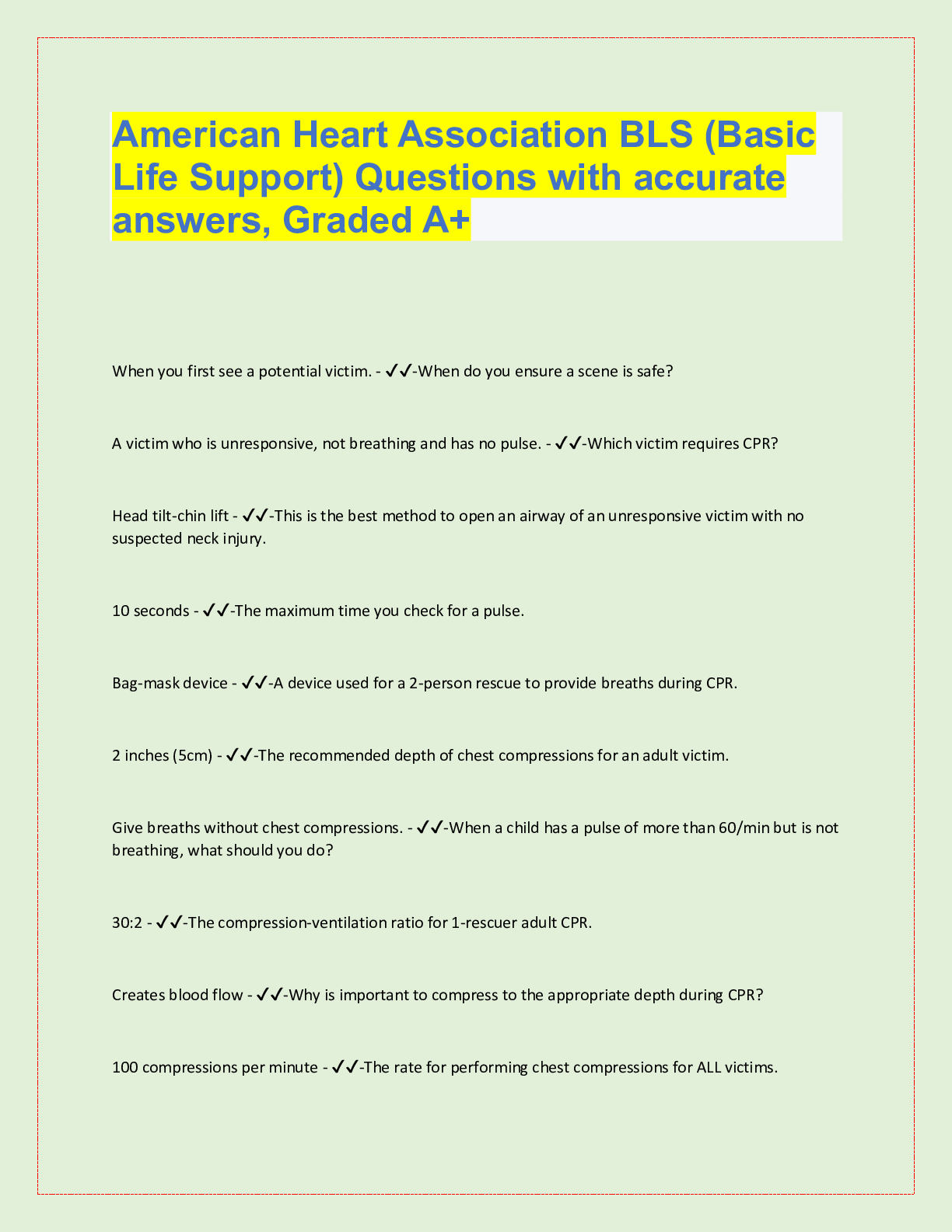


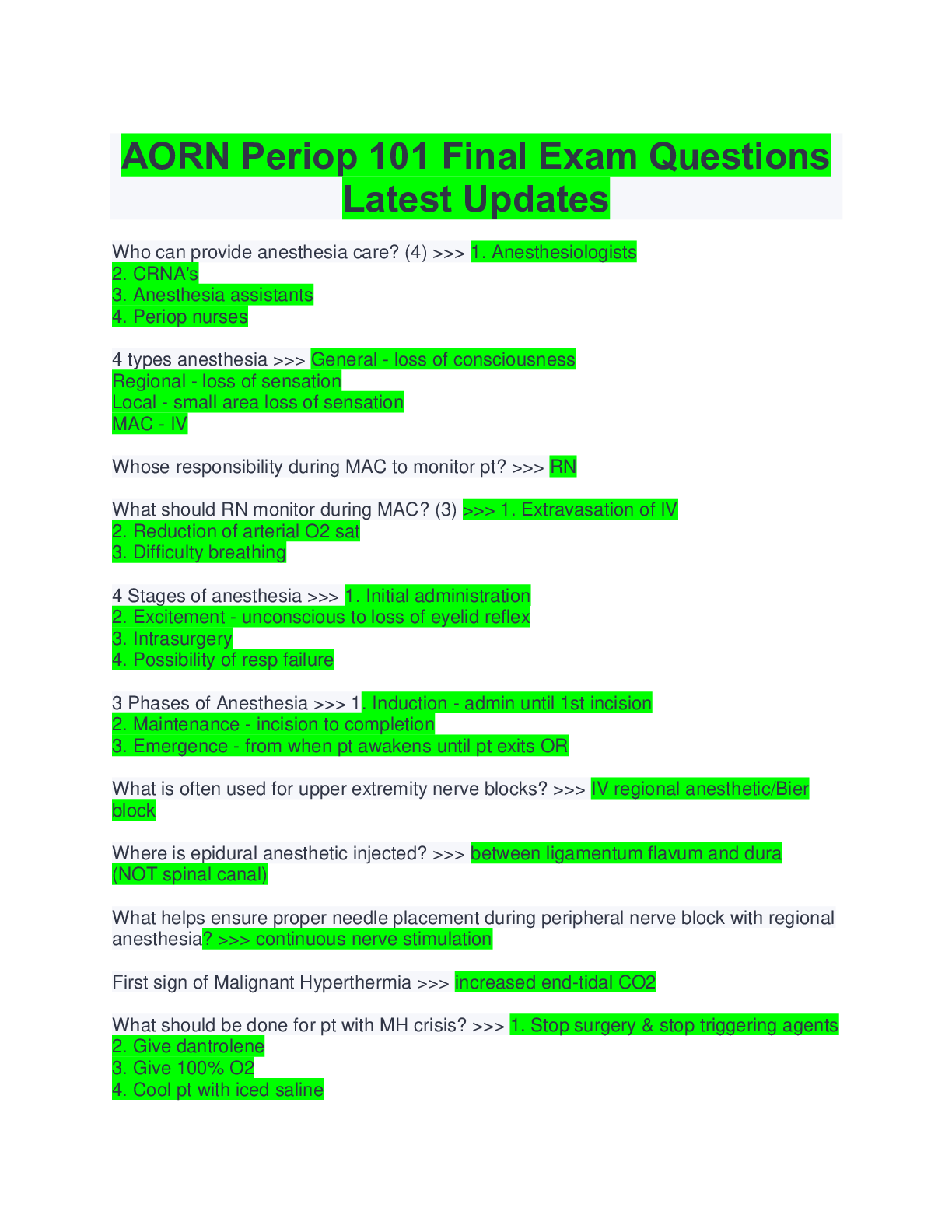






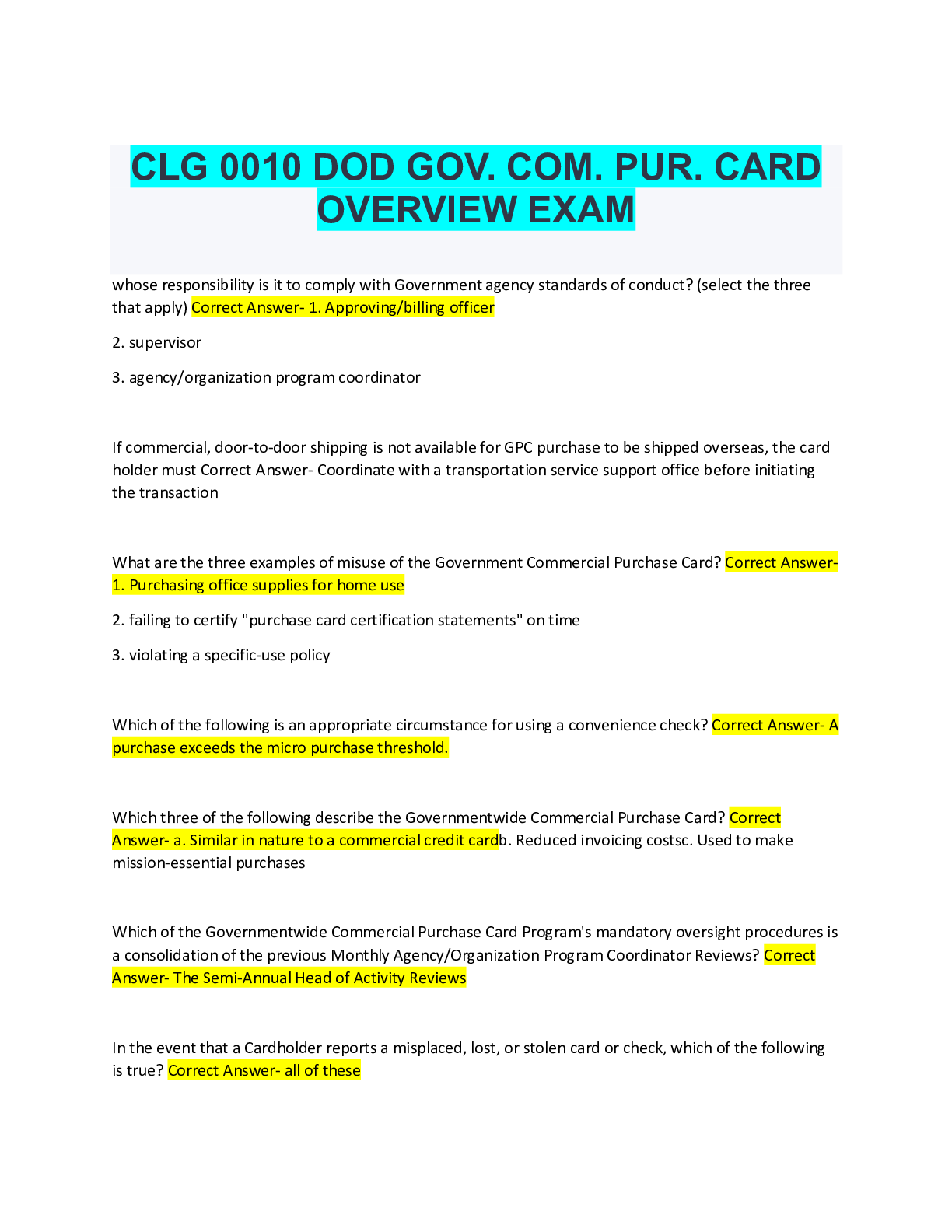




.png)
.png)
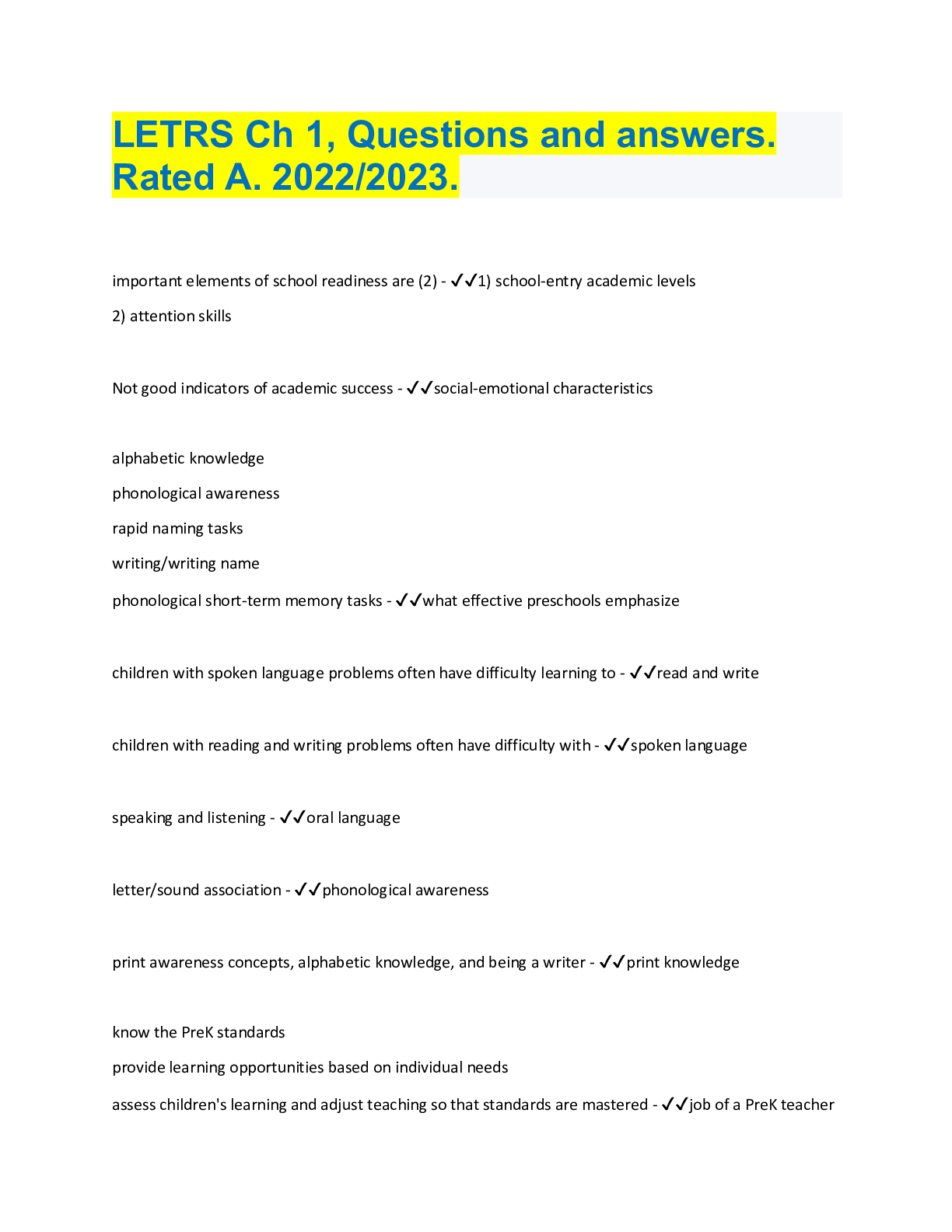
.png)
.png)
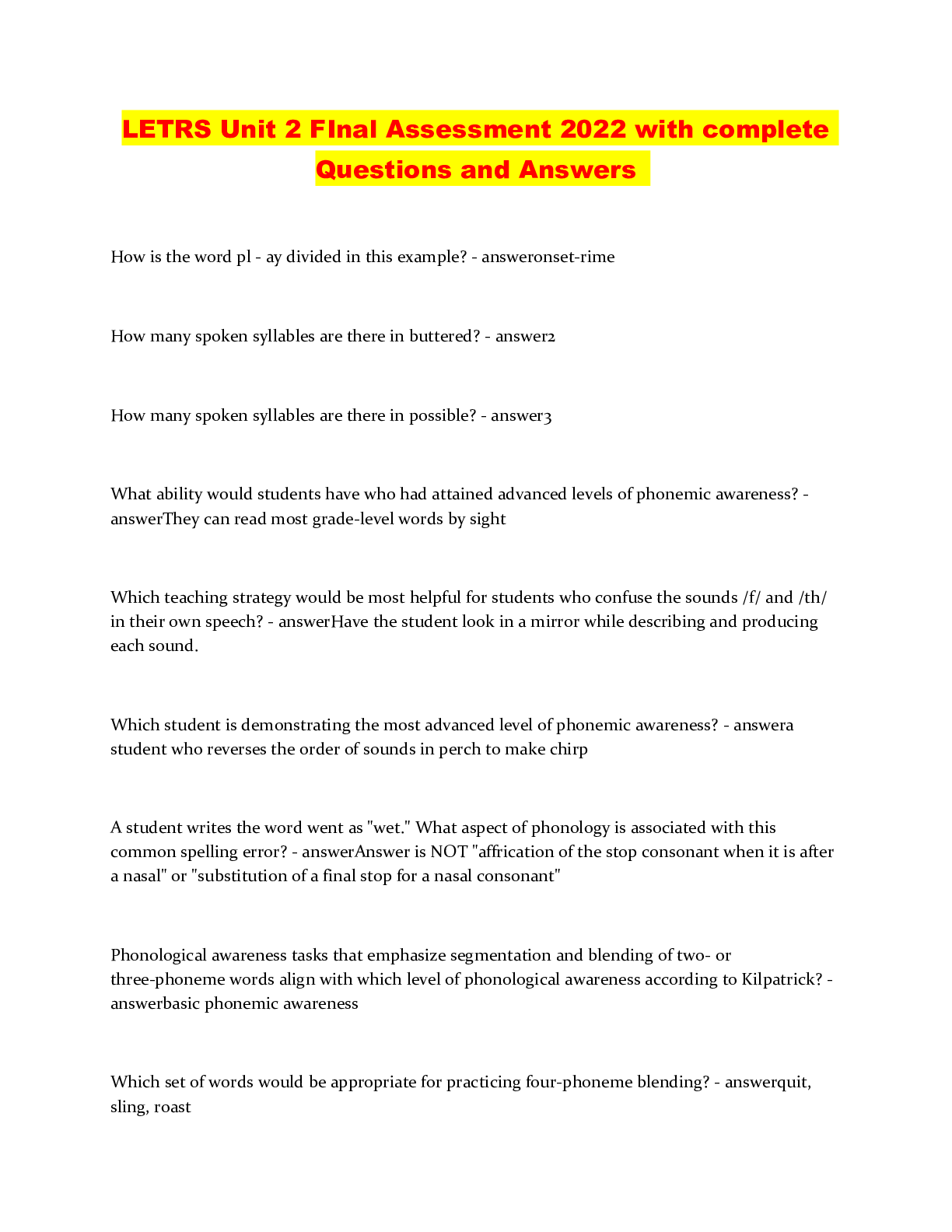
.png)
.png)
.png)
.png)
.png)




.png)

